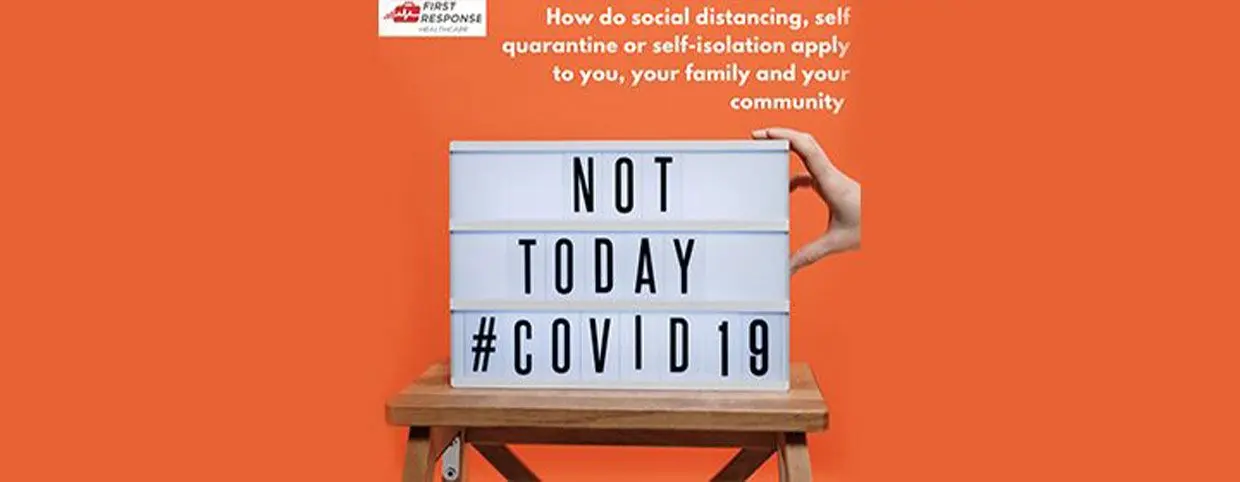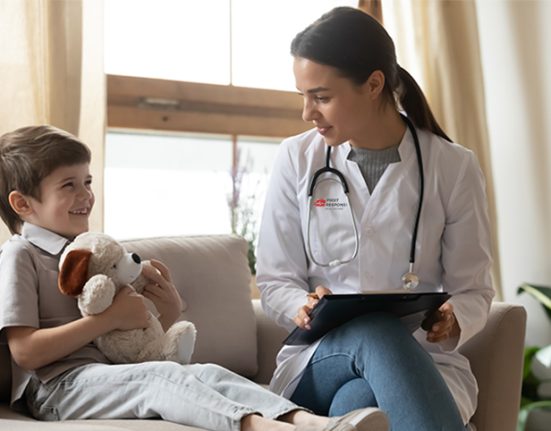Published on: 4th September 2020
Medically reviewed by: Medical Director at First Response Healthcare
Medically reviewed by: Medical Director at First Response Healthcare

The new coronavirus and COVID-19, the illness it causes, are spreading among communities throughout the world, phrases such as “social distancing,” “self-quarantine” and “flattening the curve” are showing up in the media.
What do they mean, and how might they apply to you, your family and your community?
What is isolation?
For people who are confirmed to have COVID-19, isolation is appropriate. Isolation is a health care term that means keeping people who are infected with a contagious illness away from those who are not infected. Isolation can take place at home or at a hospital or care facility. Special personal protective equipment will be used to care for these patients in health care settings.
What is self-quarantine?
People who have been exposed to the new coronavirus and who are at risk for coming down with COVID-19 might practice self-quarantine. Health experts recommend that self-quarantine lasts 14 days. Two weeks provides enough time for them to know whether or not they will become ill and be contagious to other people.
You might be asked to practice self-quarantine if you have recently returned from traveling to a part of the country or the world where COVID-19 is spreading rapidly, or if you have knowingly been exposed to an infected person.
- Using standard hygiene and washing hands frequently
- Not sharing things like towels and utensils
- Staying at home – Voluntary movement restriction of individuals
- Not having visitors
- Staying at least 6 feet away from other people in your household
- Individuals are provided with all their needs for food and personal belongings. Family members and friends will help them in carrying out daily tasks taking into consideration preventative measures to prevent the spread of infection
- Quarantined persons may be under medical supervision
- The positive aspect of such experiences is having enough time to meditate, read, watch, movies and practice hobbies.
Once your quarantine period has ended, if you do not have symptoms, follow your doctor’s instructions on how to return to your normal routine.
“Isolation separates sick people with a quarantinable communicable
disease from people who are not sick.
Quarantine separates and restricts the movement of people who were
exposed to a contagious disease to see if they become sick.”
Centers for Disease Control and Prevention
disease from people who are not sick.
Quarantine separates and restricts the movement of people who were
exposed to a contagious disease to see if they become sick.”
Centers for Disease Control and Prevention
What is social and physical distancing?
While it may be disappointing to hear that so many sports events, cruises, festivals and other gatherings are being cancelled, there is a public health reason for these measures. These cancellations help stop or slow down the spread of disease allowing the health care system to more readily care for patients over time.
Social-distancing, refers to creating physical distance between people rather than preventing social connection. It is important to connect with colleagues, friends, and family for emotional support – even if you are physically separated from them. Fortunately, this can happen virtually.
Cancelling events that are likely to draw crowds is an example of social and physical distancing. Social distancing is deliberately increasing the physical space between people to avoid spreading illness. Staying at least six feet away from other people lessens your chances of catching COVID-19.
Other examples of social and physical distancing that allow you to avoid larger crowds or crowded spaces are:
- Working from home instead of at the office
- Closing schools or switching to online classes
- Visiting loved ones by electronic devices instead of in person
- Cancelling or postponing conferences and large meetings
Self-observation means people should remain alert for subjective fever, cough, or difficulty breathing. If they feel feverish or develop cough or difficulty breathing during the self-observation period, they should take their temperature, self-isolate, limit contact with others, and seek advice by telephone from a healthcare provider or their local health department to determine whether a medical evaluation is needed.
Self-monitoring means people should monitor themselves for fever by taking their temperatures twice a day and remain alert for a cough or difficulty breathing. If they feel feverish or develop measured fever, cough, or difficulty breathing during the self-monitoring period, they should self-isolate, limit contact with others, and seek advice by telephone from a healthcare provider or their local health department to determine whether a medical evaluation is needed.
According to World Economic Forum, if you are ill, you should self-isolate. If you are at high risk of becoming sick because you were in direct contact with someone who is sick, you should self-quarantine. Lastly, if you have attended an event where someone sitting at the other side of the room later became sick, you should self-monitor.
People may be an asymptomatic carrier, which means that you show no signs of illness, however, you can pass on the virus to others. This is to be distinguished from an incubatory carrier, who transmits pathogens (an umbrella term that includes viruses, bacteria, fungi, and parasites. Covid-19 is the disease resulting from the SARS-CoV-2 virus). immediately following infection but prior to developing symptoms.
The meaning of “patient zero” is the first confirmed local case of the disease. Unfortunately, Covid-19 patient zeros can be incubatory or asymptomatic carriers of the pathogens.
Since the current outbreak, there has been widespread commentary from epidemiologists, who measure epidemiological outcomes. These are the disease outcomes relative to the population at risk. When they talk about flattening the curve, they are referring to slowing the spread of the virus through public health measures. Epidemiologists try to predict the outbreak’s peak by analyzing when the number of new infections in a single day reaches its highest point, however, it is a difficult task.
Some countries have imposed lockdowns, which is an emergency measure that prevents people from leaving or entering an area (or country). It will mean that borders are closed and people are required to stay at home and self-quarantine.
A containment zone can be established when a particular area seems to be a COVID-19 hotspot. Large gatherings are barred, but people can still come and go.
Coronavirus: What do I do if I Feel Sick?
Coronavirus is not the first pandemic to have swept across the world wreaking havoc and it seems there is precedent for these seismic health events to change cultures and create new language. Novel concepts enter the consciousness and the linguistic frames of reference shift to describe the extraordinary. There is even one instance of an entire national language switching as a result of disease. In his Biography of the English Language, C.M. Millward describes how after the Norman Conquest in the 11th century, French was adopted in England as the official government language. The demographic that mostly spoke French tended to be the aristocracy. When the Black Death wiped out a large proportion of this group, it contributed to the dwindling use of Norman French across the country. English, however, endured. And the rest is history.
What is “flattening the curve?”
Flattening the curve refers to using protective practices to slow the rate of COVID-19 infection so hospitals have room, supplies and doctors for all of the patients who need care.
A large number of people becoming very sick over the course of a few days could overwhelm a hospital or care facility. Too many people becoming severely ill with COVID-19 at roughly the same time could result in a shortage of hospital beds, equipment or doctors.
On a graph, a sudden surge in patients over a short time could be represented as a tall, narrow curve.
On the other hand, if that same large number of patients arrived at the hospital at a slower rate, for example, over the course of several weeks, the line of the graph would look like a longer, flatter curve.
In this situation, fewer patients would arrive at the hospital each day. There would be a better chance of the hospital being able to keep up with adequate supplies, beds and health care providers to care for them.
Lessening Coronavirus Impact
It’s important to know what to do if you feel sick. The coronavirus pandemic is making everyone aware of handwashing and protecting others from coughs and sneezes. Along with those essential steps, practices such as social and physical distancing, and self-quarantine and isolation when appropriate can slow the rate of infection in a city, town or community.
The pandemic can seem overwhelming, but in truth, every person can help slow down the spread of COVID-19. By doing your part, you can make a big difference to your health, and that of others around you.
For support & inquires:
Ministry of Health and Prevention – 80011111
Medical Operations Command Center Abu Dhabi – 8001717
Dubai Health Authority – 800342




